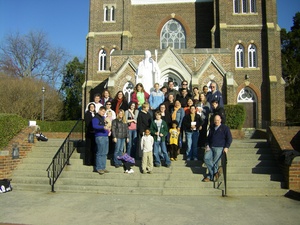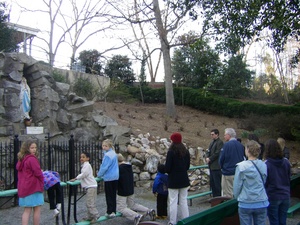Tomorrow is the 5th anniversary of death of the great priest and founder of Communion & Liberation, Monsignor Luigi Giussani. More on that later. However, the NY community of Communion & Liberation gathered at Saint Patrick’s Cathedral for the Sacrifice of the Mass celebrated by the Archbishop, Timothy M. Dolan. Among those in the sanctuary were Bishop William McCormack (retired auxiliary bishop of NY celebrating 51 years a priest today) and Bishop Gerald Walsh (NY auxiliary bishop and rector of Saint Joseph’s Seminary), Msgr. Lorenzo Albacete, Carmelite Father Eugene and Father Daniel O’Reilly with the seminarians from Dunwoodie and the collegians from St John Neumann Seminary Residence.
Tag: Luigi Giussani
Christ becoming man answers the desire for the infinite
The Christian event is the answer to the demand for the infinite which is the heart of man. So that man may walk along: “homo viator,” a man who draws near by the movement that has been put into him, that has been brought forth in him by the Mystery which makes all things and of
which he is made aware by the encounter, the encounters of life.
Keeping the centrality of Christ
Monsignor Giussani, with his fearless and unfailing
faith, knew that, even in this situation, Christ, the encounter with Him,
remains central, because whoever does not give God, gives too little, and
whoever does not give God, whoever does not make people find God in the Fact of
Christ, does not build, but destroys, because he gets human activity lost in
ideological and false dogmatisms. Fr Giussani kept the centrality of Christ
and, exactly in this way, with social works, with necessary service, he helped mankind
in this difficult world, where the responsibility of Christians for the poor in
the world is enormous and urgent.
Lorenzo Albacete recounts meeting Luigi Giussani
 When I first met Msgr. Giussani 16 years ago, I had no
When I first met Msgr. Giussani 16 years ago, I had no
idea what we would talk about. I flew up from Rome to Milan to have lunch with
“Don Gius” and a mutual friend who had arranged the meeting. I thought our
friend would guide the conversation, but the day before the meeting I learned
that he would not be there. It would just be a lunch meeting between Giussani
and myself. On the flight to Milan, I browsed through a book by Giussani that I
had picked up in order to have it autographed (L’Avvenimento Cristiano, The
Christian Event), and because our friend had told me it would help me understand
what Giussani was all about.
interests that we could discuss, I found the following remarks by Fr. Giussani:
“‘The Redeemer of Man, Jesus Christ, is the center of the universe and of
history.’ When I heard John Paul II repeating these words during his first
speech (and the same sentence was literally, my friends can witness to it, the
usual text of our meditation), the emotion I felt reminded me of the
dialectics developed between me and my students at school, and the deep tension
with which we gathered in the name of the Father, the Son, and the Holy
Spirit.” I was amazed because he seemed to be describing the same reaction
I had when, for the first time, I read Pope John Paul II’s first encyclical,
Redemptor Hominis, thirty years ago (March 4, 1979). RH begins with this
affirmation: “The Redeemer of Man, Jesus Christ, is the center of the universe
and of history. To Him go my thoughts and my heart in this solemn moment of the
world that the Church and the whole family in present-day humanity are now
living.”
Is Christ missing, or is it our humanity?
If Christ has nothing to do with what you touch and look at it, it’s not true that you are touching, it’s not true that you are looking. It’s not true that he has nothing to do with these things; rather, what’s true is that you’re not looking, touching, loving – your humanity isn’t true. In fact, you’re confused about your destiny and you’re completely skeptical about the possibility of reaching your destiny. What is human is missing: in our doubt, it’s not Christ that is missing, but rather our humanity. Msgr. Luigi Giussani
Looking forward to the Resurrection
The Sunday of the Lord’s Passion is upon us. First Vesper’s has me thinking of what the Christian life is all about and the horizon to which all Christians are facing: Christ fulfilling the Father’s promise of life eternal. We’re not talking about a fiction here, but reality.
 Let God’s people then recognize that they are a new creation in Christ, and with all vigilance understand by Whom they have been adopted and Whom they have adopted. Let not the things, which have been made new, return to their ancient instability; and let not him who has ‘put his hand to the plough’ forsake his work, but rather attend to that which he sows than look back to that which he has left behind. Let no one fall back into that from which he has risen, but, even though from bodily weakness he still languishes under certain maladies, let him urgently desire to be healed and raised up. (Saint Leo the Great, Easter Homily)
Let God’s people then recognize that they are a new creation in Christ, and with all vigilance understand by Whom they have been adopted and Whom they have adopted. Let not the things, which have been made new, return to their ancient instability; and let not him who has ‘put his hand to the plough’ forsake his work, but rather attend to that which he sows than look back to that which he has left behind. Let no one fall back into that from which he has risen, but, even though from bodily weakness he still languishes under certain maladies, let him urgently desire to be healed and raised up. (Saint Leo the Great, Easter Homily)
But the Son rose again! History is for us the continuity of Christ’s resurrection. Every moment of history, by now, is for us the way in which the mystery of the resurrection is accomplished. And at the end of this moment, i.e., at the end of history, the world, everything, everything there is, will be convinced of the intelligence that God has chosen to manifest and the grace that binds us together with which He has filled our hearts.
Do not be afraid; let us not be afraid to serve the Lord, to serve Christ with all the possibility He has given us. (Monsignor Luigi Giussani,
Luigi Giussani revealed
Sandro Magister’s recent essay, “The Mystery of Fr. Giussani, Revealed By His Writings” is a review of a recently published spiritual biography of Msgr. Luigi Giussani. The biography is still in Italian at the moment but there is an extract from Chapter 6 of Fr. Camisasca’s book illustrating the thought of Fr. Giussani. Read Magister’s article…
Father Luigi Giussani: 4th anniversary of reposing in the Lord
Christ and the Church: here is the synthesis of Monsignor Giussani’s life and of his apostolate. Without ever separating one from the other, he communicated around him a true love for the Lord and for the various Popes that he knew personally. He also had a great attachment for his Diocese and for his Pastors.
Pope John Paul II
May Father Giussani’s memory be eternal!
Father Giussani really wanted not to have his life for himself, but he gave life, and exactly in this way found life not only for himself, but for many others. He practised what we heard in the Gospel: he did not want to be served but to served, he was a faithful servant of the Gospel, he gave out all the wealth of his heart, he gave out all the divine wealth of the Gospel, with which he was penetrated and, serving in this way, giving his life, this life of his gave rich fruit–as we see in this moment–he has become really father of many and, having led people not to himself, but to Christ, he really won hearts, he has helped to make the world better and to open the world’s doors for heaven.
Pope Benedict XVI
Communion & Liberation at Belmont Abbey
Today about 25 friends who follow, that is, are a part of Communion & Liberation from around the Carolinas came to Belmont Abbey Basilica to celebrate the Sacrifce of the Mass on the occasion of the 4th anniversary of death of Monsignor Luigi Giussani and the 27th year of the recognition of the Fraternity of Communion and Liberation. Redemptorist Father Joseph Dione, a local pastor, was the celebrant of the Mass.
After, John Neill, the CL Responsible for the Carolinas, led us on a walk around the grounds of Belmont Abbey College stopping at the Saint Joseph Adoration Chapel and at the Grotto of Our Lady of Lourdes to offer a prayer of thanksgiving for the graces received today and in the past year. This was especially important to recognize since Our Lady of Lourdes is important to the life of CL because it was something that Giussani taught us: go to the BVM. So we feel very connected with the history of our charism. The group then went to dinner at a local restuarant but I had to ring bells and pray Vespers. Our group joined about 30 other groups in the USA and countless others around the world who did the same thing for the same reason.
It was a beautiful day in which we gave came together as friends to give thanks to God. Our gathering keeps the companionship and the Benedictine roots of CL alive. Some photos follow.
Communion & Liberation observes 27 years of Church approval
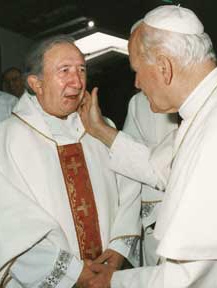 On this date in 1982, Pope John Paul II officially recognized (approved) Communion and Liberation as an authentic charism in the Church. The recognition of this fact for the Church means the work of Father Luigi Giussani and so many others was really born of the Holy Spirit. What follows are few items about the movement which come from the CL archives.
On this date in 1982, Pope John Paul II officially recognized (approved) Communion and Liberation as an authentic charism in the Church. The recognition of this fact for the Church means the work of Father Luigi Giussani and so many others was really born of the Holy Spirit. What follows are few items about the movement which come from the CL archives.
The Fraternity of Communion and Liberation
This is the eminent group among those born from the movement, whose origins and aims it shares. It was recognized as a Lay Association of Pontifical Right on
This recognition from the Pontifical Council for the Laity amounted to de facto approval of the educational experience of CL.
The first “Fraternity” groups were formed around the mid-1970s at the initiative of some former university students who wanted to go more deeply into what it means to belong to the Church, also within the conditions of adult life and the responsibilities it brings, in communion with others.
 Today the Fraternity’s groups host 50,000 people who have made the decision to commit themselves to a way of life that supports the path to holiness, acknowledged as the true aim of existence. The life of the Fraternity normally takes place through the free formation of groups who consider that commitment to be the reason for their friendship and sharing.
Today the Fraternity’s groups host 50,000 people who have made the decision to commit themselves to a way of life that supports the path to holiness, acknowledged as the true aim of existence. The life of the Fraternity normally takes place through the free formation of groups who consider that commitment to be the reason for their friendship and sharing.
Belonging to the Fraternity calls for a minimal rule of personal ascesis, daily moments of prayer, participation in encounters of spiritual formation including an annual retreat, and commitment to the support, financial and otherwise, of the charitable, missionary, and cultural initiatives promoted or sustained by the Fraternity.
Recent years have witnessed also in Italy and abroad the rise of Fraternity groups formed by diocesan priests (the first of these took the name of Studium Christi) who in this way intend to help each other pursue more deeply their vocation and the accomplishment of their mission.
On the occasion of the twentieth anniversary of the pontifical recognition of the Fraternity of Communion and Liberation, John Paul II writes Fr Giussani a long autograph letter.
Subsequently, Fr Giussani writes all the members of the Fraternity to call attention to the great value of the Pope’s letter and to the importance of the indications conveyed.
What is Communion & Liberation?
Communion and Liberation is an ecclesial movement whose purpose is the education to Christian maturity of its adherents and collaboration in the mission of the Church in all the spheres of contemporary life.
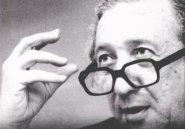 It began in
It began in
There is no type of membership card, but only the free participation of persons. The basic instrument for the formation of adherents is weekly catechesis, called “School of Community.”
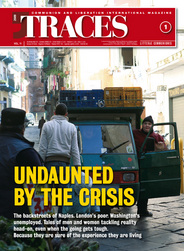 The official magazine of the Movement is the international monthly, Traces – Litterae Communionis
The official magazine of the Movement is the international monthly, Traces – Litterae Communionis
*email Kim for a subscription ($30.00 per year): traces@clhac.com
This Traces article is worth your review: A New Movement: A Story of a Beginning


